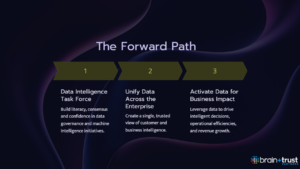Delivering a customer-centric content experience is the ultimate marketing goal. But data management issues and an impending seismic shift may prevent you from reaching it. Use these approaches to bridge the chasm that will be left when Google, Apple, and others end third-party cookie tracking.
____________________________________________________________________________________________________
Think about just how long we’ve been talking about customer centricity in marketing. Now, ask yourself how many brands have truly achieved this ideal.
On paper, it seems like we have the tools to understand our audience, unite and apply those insights to our marketing strategies, and deliver frictionless customer experiences. Yet, so few organizations manage to fully realize that potential.
One common obstacle is the lack of integration among all the technologies we rely on to deliver customer data and insights across the enterprise. Another is that data privacy regulations like the European Union’s GDPR and the California Consumer Privacy Act are making it harder to harvest that customer data in the first place.
But there’s an even bigger complication on the horizon, and it’s one that’s poised to cause the next seismic shift in marketing: the end of the third-party cookie.
For example, Google has announced plans to stop supporting third-party cookies on its Chrome browser in 2021. Meanwhile, Firefox has begun to roll out enhanced tracking protection, and Apple recently teased similar protections in its upcoming iOS14 operating system that will make it all but impossible to follow a customer across digital experiences and get a full picture of their needs, behaviors, and intent.
Of course, new market conditions, tech issues, and other barriers that exist between our brands and our customers are not new constructs. They also aren’t valid excuses for failing to lean into more efficient, direct, and personalized content marketing.
To get there, we need to take a smarter approach – starting with how we address three substantial opportunities that stand between our current state of content marketing and our ability to deliver truly customer-centric content experiences:
- Clear and transparent customer consent to collect and leverage their data
- Increased contextual awareness in our content creation and customer segmentation strategies
- Improved operational stewardship and use of that data
Establish customer consent to generate insights AND build trust
With the advent of the EU’s General Data Protection Regulation (GDPR) in 2016, data privacy compliance suddenly became a top area of focus for marketers around the world.
Or did it?
Four years later, we are still primarily addressing this issue by putting pop-up banners and tabs on our websites and asking visitors to “please accept our cookies” so we can “make our website work better for you.”
The potential loss of cookies as a vital tracking tool means we’ll soon have to rethink how we manage all our measurement processes. But in the meantime, there’s a more immediate issue for us to contend with: The many systems and tools we use to leverage those cookies as we orchestrate content experiences across our brand ecosystems often result in customer data being shared with – and even sold to – third parties without audiences knowing. It also happens for less obvious reasons even we might not know about or fully understand.
The customer data we get from all these digital experiences is critical for our content marketing strategies and tactics to work. So, what can we do to address these issues right now?
Use CMPs to help manage consent
To protect our brands and our customers from unsanctioned third-party cookies and privacy law violations, we must prioritize installing consent management platforms (CMPs) that keep a clear and easily accessible record of our customers’ consents and refusals – across all the platforms they use to engage with our content – and alert us of their preferences.
We need this information readily on hand for many purposes, not the least of which is that a customer might request to see the data we have and how we use it. Lest it sound like we are ceding control of the information we access and use to create compelling content, remember that this is no more or less than exactly what is required of us by most privacy laws.
According to Arlo Gilbert, CEO and co-founder of data privacy platform, Osano, “In an era where the regulators and the public expect increasing control over how their data is handled, it is critical that businesses ask [for] user consent to collect data in a proactive and clear way.” This goes beyond cookies and 2,000-word user agreements (which neither our marketing teams nor our customers fully read) for mobile app downloads.
When in doubt about how to handle customer data, Arlo recommends thinking back to the lessons you (hopefully) learned in kindergarten:
- Always ask permission before taking something that belongs to someone else.
- If someone asks if you have something of theirs, tell them the truth about where you got it, why you have it, and what you plan to do with it.
- If they ask for it back, give it to them without question.
“If you do those things, you’ll be in a better place than most companies,” Arlo says.
If our marketing teams expect to reach that “better place,” we need to enlist the help of technology. But as industry leaders, we have to take some personal responsibility here, too, as facilitating data compliance in a more scalable way also necessitates that we get better at working well with others – including our tech vendors.
Now is the time for content marketers to have deliberate conversations with vendors and organizational stakeholders about their API connections, signal integrity, and data privacy practices and how best to support the grand integration opportunities that are available today. While this may sound like a technology discussion that marketers aren’t fit to host, it will help us understand how our dashboards work, the ways content travels, and what is ultimately required to meet customer expectations. More than that, we must all work together to address privacy compliance in ways that earn us the trust of our customers – and assure them that the data they share with us will be handled with care.
Customer centricity can’t exist in the absence of contextual awareness
Ironically, many of the requirements associated with data privacy also may improve our ability to accurately aggregate and learn from the information customers share with us (I’ll talk more on that in a minute). Yet, in the pursuit of true customer centricity, there is just as urgent an opportunity for content across marketing and customer experiences to resonate in ways that are more personally meaningful and contextually aware.
This goal can be best achieved by having accurate, up-to-the-minute audience insights to inform our campaign strategies, focus our messaging, and guide our efforts to personalize content for each and every audience segment, if not individual customers. But if we want to get there more quickly and efficiently, we need to expand our access to insights by involving our customers directly.
One way to approach this is to ask our audience to provide us with directional feedback, opinions, testimonials, and reviews, alongside having them directly share rich media – such as photos or videos of them using our products and services.
The quantitative and qualitative information customers provide after having made a satisfying purchase from us, subscribed to our content, or interacted with our brand in other positive ways delivers much richer, more contextually aware, and more useful insights than the transactional clicks we observe and the signal data we measure on our content performance dashboards.
Bonus benefit: greater content scalability
If we can facilitate more personal exchanges with customers and empower them to co-create our brand stories, the targeted messaging that results will be more compelling and successful. It can also help enterprises scale content creation – and do so at a lower expense and enhanced value proposition than many brands can manage by relying on content team resources, external agencies, and other creative partnerships.
“By enabling customers to document their experiences in the form of videos, photos, audio, and narratives, they speak truth to other consumers in ways that brand-driven narratives cannot. The brand and retailer thus become the conduit by which consumer content – and the experiences within – is exchanged,” says Mike Svatek, CEO and founder of Rivet Works, a user-generated content and customer feedback platform.
Mike adds, “Businesses that adopt that mindset return to the essence of their responsibility in our economy — connecting people with the product, service, or experience they want, and in a way that is resilient to changes in data policies and regulation.”
Better data stewardship is key to overcoming our operational obstacles
When we mishandle how we collect, contextualize, and apply customer data, it can negatively impact our ability to understand their behavior, preferences, and purchase intent. Even worse, it can create unnecessary operational friction, inefficiency, and costly redundancies – in our content processes and across multiple other functions of our business.
“Contextual relevance goes beyond marketing. It spans the entire customer journey. Personalization is not just about what you expose and to whom. It also includes when you expose it. And, as customers move through the customer journey, their needs will further evolve. Contextual relevance must be helpful, must support customer self-service, and, most importantly, must build trust,” says Megan Gilhooly, vice president customer experience at Zoomin.
She adds that when departmental teams have a common process for tracking both technology and customer issues, the entire company can learn from trends that reveal opportunities and uncover issues and greater systemic problems. Solving the root causes behind these trends can help keep teams productive and focused on customer needs rather than wasting time and losing opportunities.
This is also a budget and financial concern for our businesses. We who operate in marketing, communications, and customer service capacities commonly require access to the same kinds of customer data to do our respective jobs, yet we each store, organize, access, and report on it separately through siloed departmental processes and tech systems. This means an organization can be paying to process the same data sets three or more times across its various functional divisions.
This redundancy is costly, for sure. But it can also lead to an even bigger issue from a marketing operations standpoint: misinformation, which can result from not having access to the best data, lacking a unified view of business and customer insights, or contending with unresolved analytics conflicts when working across disparate team dashboards and tech tools.
What can we do about it?
Content marketing leaders must look for opportunities to reconcile and correlate all the different data a brand collects across tens of software tools (if not hundreds of systems for enterprises) and disparate business units that are charged with overseeing customer experiences and journeys.
According to Tom Treanor, CMO of customer data platform Treasure Data, “Companies increasingly need to focus on better collection, management, and utilization of first-party customer data. Tools like customer data platforms (CDPs) allow companies to collect data from multiple company silos, unify the profiles to get a ‘golden record’ on each customer, and activate it across multiple channels for a more personalized and seamless omnichannel experience.”

“Companies that manage massive volumes of customer interactions, like retailers, financial institutions, or those in the hospitality industry, need to do a better job of understanding their customers – often by stitching the customer interactions together using a CDP. Utilizing a CDP, these brands are able to collect first-party customer data, understand their customers better, and focus on customer acquisition, customer satisfaction, as well as customer retention,” Tom says.
Bonus benefit: better customer identity management
Many CDPs on the market today also enable marketers to resolve redundancies in our customer records, such as those who access our brand’s content from multiple email addresses, different devices, and social IDs, and use differing payment methods on transactions. Yet, this is where we stand to build a much clearer and accurate view of both individual customer history and behavior and to go beyond rudimentary personas to create more accurate and impactful audience segmentation strategies.
After unifying and resolving customer data in a CDP, marketers should verify the authenticity and correctness of that information before using it to construct a customer profile. This can be done in part by allowing customers to update their own data records (as privacy laws call for). But working with a dedicated consumer identity management platform can also be instrumental. Not only can it help reconcile discrepancies and duplications, but it can also serve more strategy-focused marketing purposes.
According to Chad Hatch, chief revenue officer at Audience Acuity, “Creating a cohesive customer journey starts with identity resolution from the moment they begin to interact with your brand. Utilizing a complete offline-to-online identity graph with persistent linked IDs will help brands maintain a consistent understanding of their customers’ identity across their entire ecosystem. This in turn will enable them to deterministically identify and contextually engage audiences in an omnichannel capacity, in a privacy compliant manner, and at scale.”
If we are no longer able to track a customer across the web, apps or devices, identity management is the best way to ensure the customer records and information we already use in content strategy are accurate and true. Chad says, “If brands desire to resolve the identity crises and create relevant experiences in a post-cookie world, they will need to build deterministic 360 profiles in a CDP platform for both known customers and unknown visitors, fueling the brand’s ability to personally identify and engage both customers and prospects contextually at the same time in a real-time manner.”
It is critical to respect the rigors of data privacy and consent management when using any marketing technology, especially CDPs and identity management platforms. This is not only required for regulatory compliance, but it can also open up new content opportunities to tell the world how we have given control to the audience – and demonstrate to that audience that we respect their privacy.
Better data stewardship solves a host of post-cookie marketing challenges
We must find better ways to make technology and media work for us, not against us, so that we may create content that can be measured in true business outcomes like sales and increases in the lifetime value of our customers. It is content that accounts for the personalization of our brands and the confidence and trust we build with our audiences. Today, it is well within our current capabilities, but we need our content to be better informed by accurate, contextually relevant customer data that is managed in the most efficient, cohesive way possible if we want to keep our businesses moving forward.
This feature article was originally published in the August 2020 issue of Chief Content Officer magazine, reprinted with permission.








great explanation, privacy maybe great issues in next few years, include cookies
Leave a comment